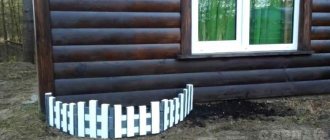There are many options for designing a yard.
Various compositions are created from what would previously have been thrown away - things and objects that have served their purpose...
If you have accumulated old tires, then do not rush to throw them away - you can use them to make a path in your garden, vegetable garden or dacha.
If you approach this process creatively, you can not only beautifully decorate the territory, but also secure it .
There are several popular ways to arrange your site, which will be discussed further.
Path layout
An already formed area does not require additional planning when constructing paths. In such a situation, roads are laid from point A to point B (from the utility room to the cottage, from the house to the toilet). But if you have not yet decided on the layout of your plot, and you don’t want to walk on wet grass and mud, you should think about what you might need to do, you need to create temporary paths that can easily be removed and moved in the future.
It is also necessary to select the appropriate material and construction technology. Based on the above, you need to plan everything in order to understand where temporary and main garden paths made of tires will be laid, with a good foundation underneath them.
Reference! The width of the path is also considered an important factor in planning. If it is planned to build a fundamental path that will be constantly used, it is necessary to take into account the width; two people must move freely. For such a road, a width of at least 1-1.2 m is required. When constructing paths, it is quite important to take into account the future load, soil characteristics, and groundwater level.
Handy tools for budget paths
Garden paths are traditionally laid along well-trodden paths, when in this way the issues of a short path, ease of movement, and reducing the distance to other objects are resolved. For these purposes, you can use available material.
This can be done at low cost by analyzing the resources at your disposal:
- remnants of building materials used in the construction of the house - crushed stone, fragments of decorative tiles, wood;
- trunks of cut trees and thick branches obtained when renewing plantings in the garden, clearing the territory;
- bottles, glass and plastic, accumulated in the city or even collected from the nearest spontaneous garbage dumps;
- rubber tires that have become unusable and collected near a tire shop;
- wooden and plastic boxes collected from any market;
- metal utensils that are no longer needed;
- old furniture taken to the dacha.
Simple and affordable options include wood, leftover building materials and glass bottles. Cheap raw materials, simplicity of the installation process, accessibility, and relative durability quickly brought them to the top of the ranking of garden paths, which can be quickly equipped with your own hands at low cost. For those who come to the country to relax and unwind, this is the most suitable solution.
Rules for arranging paths
There are rules that need to be taken into account when arranging roads:
- drainage system (base) - adding sand or sand particles with crushed stone, at least 10 centimeters thick, is used on a loose soil layer. On soil that slowly absorbs moisture, you need to add about 15 cm of crushed stone. Thanks to the above actions, your road will lie on a hard base.
- slope - all roads must be made with a slope, either in one direction, or with a hump on both sides. This is important for steps and platforms; the slope should have the following parameters: one centimeter per meter of path.
- The more the path is loaded, the thicker the base of sand and gravel should be added.
- groundwater - if in your area in the spring after snow melts or after heavy rains the liquid does not drain for a long time, this indicates a high level of groundwater.
There are two solutions:
- We form a cushion of sand and gravel above the ground.
- The second option should be used if there is a ditch or drain.
Let's consider the option of draining water from the surface by laying drainage. Along the edge, on the side where the slope of the path leads, a special pipe is mounted, it runs along the entire path of tires for the garden, and reaches the rain well. After a certain distance, storm water inlets can be placed on the path. It is better to install a drainage type pipe with a slope towards the drain of 1 cm per 1 m of running pipe.
Roll coverings
You can also improve the area using recycled rubber, but in the form of rolls that can easily be rolled out over the surface.
This track retains all the properties of rubber, while looking much more elegant . This is an elastic and reliable material that is pleasant to walk on in any weather.
It is installed under the following conditions:
- You need a base - concrete or asphalt.
- It is covered with special glue, after which the roll is carefully unrolled along the path.
The covering method is convenient if the base is already quite damaged - in this case, the rubber track will hide traces of damage .
There are many colors and sizes, so you can get confused when choosing.
This option is also more practical - installation is easier, the path looks aesthetically pleasing. But the cost of such rubber rolls will be higher.
Pros and cons of using tires in path construction
Main advantages of tires:
- Quality. Despite the period of use, the tire remains resistant to temperature changes. Its visual appearance does not deteriorate even during precipitation.
- The trails are easy to maintain. You just need to sweep away the debris and periodically water it with a hose.
- A path made from tires is a safe method of arranging a site. Even after heavy rain, the rubber dries quickly and practically does not slip if you care for it properly.
- The ease of making it yourself is perhaps the main advantage of such a path.
The only disadvantage of this material is that it requires a large amount. But it’s not difficult to buy tires, because now there are many car services.
Photos of country crafts made from tires
Tires standing in a row, cut in half, serve as very convenient bicycle parking. Elastic rubber will hold any size wheel.
If the old tire is on the rim, there is no need to remove it. After some work with a jigsaw, the wheel will become a reliable stand for an unusual flowerpot.
An aggressive piranha, attached to a stalk in the middle of the garden, will scare away thrushes and other impudent lovers of dacha plantings.
A donkey moving a flowerbed on wheels serves as a very non-trivial country installation that any guest of a country house will appreciate.
If there are swings for people, then why not make swings for flowers. Suddenly they will begin to bloom better!
The swans are already there. Apparently there will be a lake soon!
The pink flamingo will definitely become the favorite of all the little household members.
Manufacturing methods
There are several options for processing tires, the choice of which depends on skills, availability of tools and preferences. For tracks, it is worth looking for winter tires that are quite resistant to temperature changes.
From whole tires
Using rubber tires, you can make a path on relief terrain. To do this, you will need to figure out the route and the amount of building materials. It is also important that the track is securely fastened to the base. The tires are laid flat on the surface and deepened into the soil layer.
By filling the recesses with turf or a sand-gravel mixture, you can form a staircase-path. To do this, the tires are laid flat, starting from the bottom of the plot and going up. This method will help to lay the material twice as fast and create a pedestrian connection between the necessary points.
You can use tires to lay out a trail alternately in two parallel rows. When wet, the side of the tire begins to slip, so it is better to be more careful if it starts to rain. Such a road can be removed at any time or parts can be swapped to change the design.
You can make a fence from whole tires. To do this you need to throw them on top of each other.
The bottom ball of auto wheels is buried in the soil layer, and the upper rows are strung on wire. Recesses in tires are made using an awl. Such fences are easy to maintain. It can be poured with water and painted in any color scheme.
Original garden figures
We have already studied some options, but now we are moving on to real fairy-tale characters that can appear in any dacha.
First of all, we present bears made from car tires, which are organically formed and installed, decorated and endowed in a special way. As you can see, next to them are the cute flowers made from plastic bottles that we talked about recently.
Next we have beautiful swans at the entrance to the summer cottage. This is a more delicate and lengthy work that requires free time and some skills.
Next up is the caterpillar, which really couldn’t be simpler. It's a nice little shape of vertically mounted tires that fit snugly together at slightly different heights. Painting and simple decoration help complete the look.
At the very beginning of the article, we mentioned wooden horses and showed you a donkey made from tires, but now we have come to a horse made from an old tire, the construction of which and its complete design will take you no more than a couple of hours. Agree, this is not much to create a favorite country toy for children or grandchildren. The shape is formed very simply - a tire is installed in a small hole and concreted. Next, it is decorated and tinted, complemented by a head and mane, and immediately after that it becomes a nice object in the exterior of the dacha.
Preparatory activities
Before laying out the path, you need to plan everything. It’s better to make a diagram on paper with all the components that complement the trail:
- fencing;
- gutters;
- drainage systems;
- lighting devices.
Important! It is also necessary to measure tires in order to understand how many products will need to be prepared. And this will depend on the length/width of the path, its shape and the route of laying.
How to do the installation yourself - let's look at it step by step
To make a beautiful path from old tires, you need to take a responsible approach to each stage of the work. So, how to make paths in the country from tires, detailed description:
- Preparation of building materials . It is necessary to carefully separate the tire rim from the tread strip. Tool for work - an electric jigsaw or a sharp knife. The rim is separated precisely along the edge of the tread. This will make the cut material easier to straighten. The jigsaw should be driven around the circumference of the tire, and not across it.
- Creating a ribbon . To do this, the protector is cut with a knife. The number of stripes depends on the selected road dimensions.
- Creating the strongest foundation for the trail . A hole is dug to the depth of a spade bayonet. The bottom is compacted. A layer of crushed stone or gravel is poured. From above everything is filled with a sand-cement mixture. But you can do without this. For non-heaving soils, you only need a gravel cushion.
- Alignment and fixation of tapes . It is carried out using treated wooden slats. The edges of the material are straightened and attached to the slats using nails.
Recommendations and common mistakes
In order for the paths from old tires in the country house shown in the photo below to last as long as possible, it is important to consider the following tips:
- Rubber is laid only on a pre-prepared base. The soil is cut, compacted and leveled. Only after this they begin to lay out the tires. If you do not heed this recommendation, the finished sidewalk will quickly deform.
- A properly formed hard backing will prevent damage to the rubber from rocks underneath.
- Rubber tracks should not be considered completely safe. In hot weather, they become very hot and begin to release dangerous toxic substances. To avoid poisoning, it is important to cover the path with paint.
- Raw materials for rubber tracks can be obtained from a tire shop or a specialized store.
To make the path strong and durable, the base can be made of concrete.
If the soil is too clayey, it is important to first make a proper base for the rubber track. To do this, dig a ditch 30 cm deep. The bottom is covered with sand and crushed stone. It is important to compact each layer thoroughly. Old tires are laid flat on the prepared area. If you do not pre-prepare the base for paths on clay soil, the pavement you make will quickly fall apart due to the “buoyancy” of the soil.
Laying in different directions creates a weaving effect
The ribbon path can be laid in several rows
For row spacing, it is enough to place the tapes in 1-2 rows
Painted elements look more presentable
Using rubber squares you can make a coating of any width and length
Decorating paths
Almost all land owners want to expand their territory, not reduce it. Therefore, tips on how to make paths more useful through decoration and visually enlarge them will definitely come in handy.
You need to start by choosing the right vegetation to plant along the path. Lush flowers, voluminous bushes and spreading conifers will take up a lot of space. Therefore, it is better to replace all this with compact vegetation. You can decorate the paths with marigolds, creeping roses and junipers that grow low.
You can also landscape the area along the path with a lawn by simply ordering seeds from the store and planting them in the substrate. You can make a lawn on both sides of the road or on one side, freeing up some space.
Recommendations related to the choice of lighting for roads are also important. Lighting devices should not be large and have many different functions. A good solution is LEDs, duralight strip or small garden lights. These devices have acceptable dimensions and will also help make the path illuminated and safe.
Before planning tire paths for the garden and determining the width of their paving, gardeners must understand that not only the visual appearance of the garden plot, but also its convenience, functionality, and safety will depend on their actions. Therefore, the routes and parameters of each road surface must be plotted and agreed upon before starting construction on the site.
Idea No. 2. Tire figures
Another type of crafts made from tires for the garden are a variety of unusual and intricate figures made from tires. They will enliven your garden and improve the mood of everyone in the household.
The figure of a swan is very popular. To make it you will need a tire without metal cord. It must be pre-marked.
For cutting, use a well-sharpened knife. Secure the swan neck with a metal rod. The final step is to coat the resulting product with white or black paint (depending on what kind of swan you want - white or black).
It’s enough to simply create a funny horse, zebra or giraffe. Such figures will require a medium-sized wooden beam to be installed in the ground along with a tire.
Crafts should be painted in colors corresponding to a particular representative of the fauna.
It's easy to turn old tires and cans into a frog or a cute turtle. A little imagination will help you make interesting and unusual installations.











